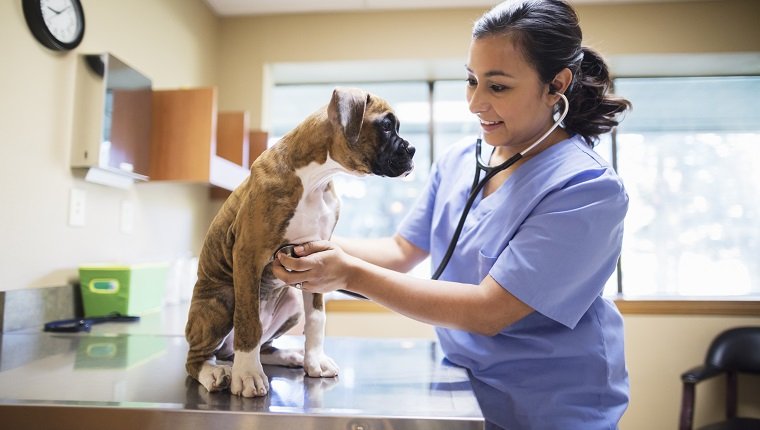Addison’s disease in dogs, also known as hypoadrenocorticism, affects the production of hormones in the adrenal glands, which are located near the kidneys. These hormones are mineralocorticoids and glucocorticoids, natural steroids produced by the body.
With Addison’s disease, a dog’s body doesn’t produce enough of these steroids, which include cortisol that regulates metabolism of sugar, fat, and protein as well as regulating the fight or flight response in stressful times, and aldosterone that regulates the electrolytes sodium and potassium.
When the disease causes the adrenal glands to reduce production of steroids, it can lead to further serious symptoms in dogs unless proper treatment is given. If you see the signs in your dog, you must consult your veterinarian right away. Here’s what you should know about the symptoms, causes, and treatments of Addison’s disease in dogs.
Symptoms Of Addison’s Disease In Dogs

There are a variety of symptoms that appear in dogs with Addison’s disease, and that can make it difficult to diagnose. These symptoms may also flare up and fade away in bouts over time.
Some symptoms can be life-threatening in severe, acute cases of the disease.
Here are several of the symptoms that may appear:
- Depression or lethargy
- Anorexia or lack of appetite
- Vomiting
- Diarrhea or bloody stools
- Weight loss
- Shaking
- Dehydration or increased thirst
- Frequent urination
- Weakened pulse or irregular heart rate
- Lower body temperature
- Hair loss, also known as alopecia
- Pain in the abdomen
- Collapse, known as an Addisonian crisis where an imbalance of electrolytes and metabolism during stress causes a state of shock
- Hypoglycemia (low blood sugar)
- Skin hyperpigmentation
Causes Of Addison’s Disease In Dogs

The most common cause of Addison’s disease in dogs is immune mediated destruction, a condition where the immune system attacks the body’s own tissue. This can damage the adrenal glands and cause them to fail.
Trauma, tumors, or infection may also damage the adrenal glands. These conditions are not usually preventable.
Another cause of Addison’s disease is a failure of the pituitary gland to secrete Adrenocorticotropic hormone (ACTH), which stimulates the adrenal gland. The hypothalamus may also fail to produce adrenal gland regulating hormones.
The pituitary gland and the hypothalamus are located in the brain and may fail if there is some kind of tumor, inflammation, or injury.
Addison’s disease may also appear in dogs who have received medication for Cushing’s disease, which results in the adrenal glad overproducing hormones. Medications for Cushing’s disease suppress the overproduction, but in some cases can be too effective and cause an underproduction of hormones.
Also, a dog who has received treatment with steroid medication and abruptly stops may develop Addison’s disease.
Addison’s disease most commonly affects young or middle-aged female dogs, though dogs of any sex and age develop the condition, as well.
It can also appear in any breed of dog, but some breeds are more predisposed. These include:
- Bearded Collies
- Great Danes
- Nova Scotia Duck Tolling Retrievers
- Portuguese Water Dogs
- Poodles
- Soft Coated Wheaten Terriers
- West Highland White Terriers
Treatment For Addison’s Disease In Dogs

To determine if your dog has Addison’s disease, a vet will administer an ACTH stimulation test once other causes of symptoms have been ruled out.
In normal dogs, this test will cause the adrenal gland to produce cortisol, which is measured in the blood. However, in dogs with Addison’s disease, the cortisol levels will not be sufficiently elevated.
In the case of an Addisonian crisis where a dog has collapsed, treatment is a medical emergency. This requires hospitalization and intensive therapy. The vet will likely give the dog intravenous fluid to replace deficiencies, followed by corrective hormone supplements.
Once the disease is initially treated and under control, the dog will need to receive replacement hormones for the rest of their life. There is no cure for Addison’s disease.
Your vet may adjust the dosage of replacement hormones frequently, especially at first. Florinef is the most commonly prescribed drug for Addison’s disease and is given twice a day. DOCP is a newer injection treatment given once every 25 days that is also effective.
Your vet may want to supplement these medications, and they can give you specific instructions for your dog. The good news is that, with proper treatment and monitoring, a dog with Addison’s disease has the same life expectancy as one without the disease.
Does your dog suffer from Addison’s disease? What kinds of treatments do you use? Let us know in the comments below!









